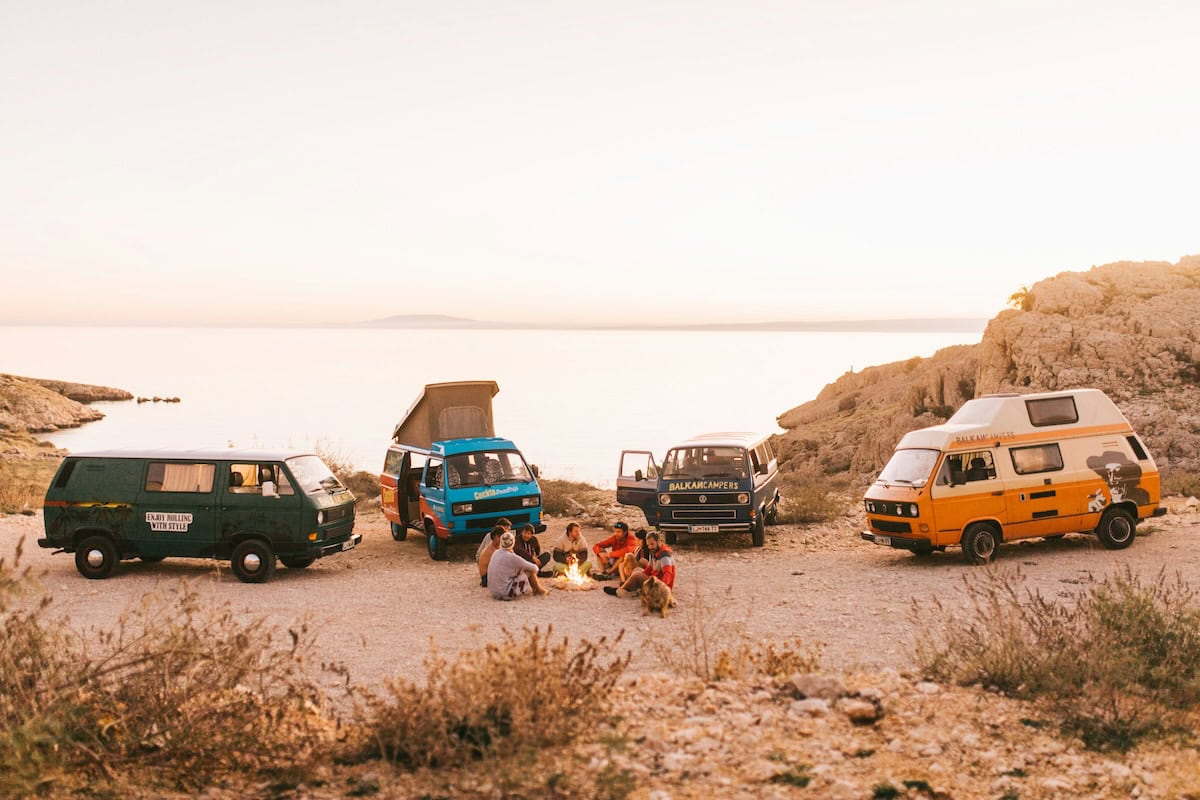
The 8 Best and Worst Vehicles for Your Road Trip Adventure
By: Frayed Passport
Skip to Section
Article Summary
Your road trip vehicle can make the difference between epic adventure and epic disaster. Choose wisely, because nothing ruins a cross-country dream faster than being stuck with the wrong ride for 3,000 miles.
This guide breaks down the best and worst vehicles for road trips, from touring motorcycles that connect you to every mile to RVs that let you wake up anywhere with ocean views. You’ll get the real talk on SUVs that handle everything from family chaos to mountain passes, plus the honest truth about why your beloved sports car might not be the hero of this particular journey. The article covers practical considerations like fuel costs, comfort levels, and storage space to help you pick your perfect road trip companion.
- Touring motorcycles offer incredible fuel efficiency and highway comfort but leave you exposed to weather and limited on cargo space
- SUVs provide the sweet spot of passenger comfort, cargo capacity, and all-terrain capability, though gas mileage takes a hit
- RVs give you ultimate freedom to wake up anywhere but demand serious driving skills and fuel budgets that’ll make you wince
- Small cars and sportsbikes look tempting but can turn long highway stretches into endurance tests
- Classic cars look amazing in photos but lack modern safety features and reliable parts availability for remote breakdowns
So you’re planning a road trip? Excellent choice! Nothing beats the freedom of the open road, your favorite playlist, and the promise of adventure around every corner. And your choice of vehicle can make all the difference between the best trip ever and a frustrating chore.
Let’s break down which vehicles will be your trusty road trip sidekick and which ones might leave you stranded (literally or figuratively) on the side of Route 66!
The Road Trip Champions
Touring Motorcycles
If you’ve ever dreamed of feeling completely connected to the journey, a touring motorcycle might be your perfect match. These beauties are built for eating up highway miles without stressing your spine.
The Pros: You get a relaxed riding position that lets you cruise for hours without feeling like you’re hunched or stuck. The windshield keeps bugs out of your teeth, and the saddlebags hold more than you’d think. Plus, the fuel efficiency can’t be overlooked. Modern touring bikes even come equipped with heated grips, cruise control, and sound systems.
The Cons: Weather! You’ll need to add hefty rain gear to your budget, and extreme heat or cold can test your dedication. You’re also limited on cargo space compared to four-wheeled options. And if you want to travel with a friend, they’ll need their own bike (or a different type of vehicle entirely, depending on their comfort level).
SUVs
When it comes to versatility, SUVs are hard to beat. They’re the Swiss Army knife of road trip vehicles, ready for whatever adventure you throw at them.
The Pros: Lots of space! You can pack everything from camping gear to your kids’ favorite oversized plushies. The higher seating position gives you a commanding view of the road (and helps spot a perfect roadside diner). Most modern SUVs have comfortable seating for 5-7 people, so there’s plenty of room for everybody.
Safety features in today’s SUVs are impressive, too. Adaptive cruise control, lane-keeping assistance, and blind-spot monitoring make long highway stretches less stressful. And if your road trip takes you off the beaten path, many SUVs have all-wheel drive to handle whatever nature throws your way.
The Cons: Gas mileage isn’t always stellar, especially with larger models. Parking in crowded cities and smaller spots can be a challenge. And while SUVs handle well, they’re not as nimble as smaller vehicles when you’re exploring narrow mountain roads or quaint downtown areas.
Minibuses
Got a big group? A minibus lets everyone join the adventure!
The Pros: With 9-15+ seats, you can bring the whole gang and still have room for everyone’s luggage. No more convoys getting separated at traffic lights, and everyone gets to be part of the group. Modern minibuses have surprising comfort features, like individual climate controls, USB ports for every passenger, and tons of cupholders.
The Cons: You’ll need confidence handling a larger vehicle, especially in older parking lots with smaller spaces. Fuel costs add up quickly with a bigger engine and more weight. And finding accommodations that can handle your entire group might require more advance planning.
RVs
Ah, the RV life! It’s a whole different way of experiencing the road.
The Pros: Wake up to ocean views without paying beachfront hotel prices. Cook breakfast in your own kitchen while still in your pajamas. Take bathroom breaks whenever nature calls without searching for the next rest stop. RVs give you the freedom that other vehicles can’t match. You’ll save money on hotels, though you’ll want to book some nights at RV parks for full hookups – they can provide electricity, water, and sewer connections, plus amenities like showers, laundry facilities, and sometimes even pools. You’ll also have the chance to meet fellow travelers and share road trip stories around the campfire.
The Cons: RVs guzzle gas like crazy. We’re talking 6-10 MPG for most Class A and C motorhomes. Driving one takes practice, especially backing up (it’s good to have a spotter or invest in a good backup camera). Some roads and bridges have height or weight restrictions that limit where you can go. And while you save on hotels, RV parks, maintenance, and fuel costs add up.
The Most Challenging Road Trip Vehicles
Sportsbikes
Sportsbikes are incredible machines – but they’re not the best for road trips.
Challenges: The aggressive forward-leaning position is awesome for about 30 minutes. After three hours, you’ll be begging for a chiropractor. Storage space is extremely limited, and fuel efficiency suffers when you’re constantly fighting wind resistance at highway speeds. If you’re dead set on two wheels, consider renting a touring bike for the trip and save your sportsbike for weekend canyon carving.
Small Cars
Small cars have their place, but cross-country road trips might not be it.
Challenges: Your Mini Cooper gets excellent gas mileage, but you have minimal storage space, especially if you’ve got passengers. And highway driving in a small car can be a bit scary – you’re constantly buffeted by wind and can feel every single vehicle pass you, which can be exhausting if you’re a bit of an anxious driver.
That said, if you’re traveling solo or as a couple with minimal gear, and your route focuses on cities rather than wide-open spaces, a small car could work. Just be realistic about comfort on those long stretches of highway.
Short-Range EVs
Electric vehicles are excellent for many things, but they’re not quite there yet for long road trips.
Challenges: With a range of 150-250 miles, many EVs require frequent charging stops. Finding fast chargers in remote areas can turn into an unwanted treasure hunt. Charging takes longer than filling a gas tank, even with fast chargers – taking several 30-minute charges throughout the day can make you feel like this isn’t a road trip anymore, but a hunt for the next charging station.
However! If you’re sticking to major highways and cities, EVs can work beautifully. Apps like PlugShare help you plan routes around charging stations.
- For greater go-anywhere freedom, at least for now, hybrids may be a better compromise, using electricity when available and gas when needed.
Classic Cars
Who wouldn’t want to take a cross-country road trip in a 1967 Mustang? It looks awesome and turns heads everywhere!
Challenges: Modern safety features didn’t exist when these beauties were built. That means there are no airbags, no crumple zones, and no stability control. Air conditioning might be nonexistent or barely functional. Reliability can be questionable, and if you need a spare part or emergency repair in a rural area, you may be out of luck.
You might want to save the classic for shorter weekend drives and local shows. Rent something modern for the epic road trip and keep your baby safe in the garage!
Happy Travels!
Featured image by Balkan Campers on Unsplash
Information published on this website and across our networks can change over time. Stories and recommendations reflect the subjective opinions of our writers. You should consult multiple sources to ensure you have the most current, safe, and correct details for your own research and plans.
Frayed Passport is a participant in the Amazon Associates Program, an affiliate advertising program designed to provide a means for sites to earn advertising fees by advertising and linking to Amazon.com. We also may share links to other affiliates and sponsors in articles across our website.




